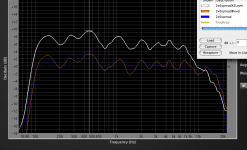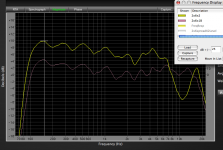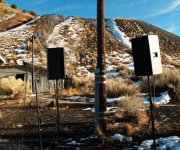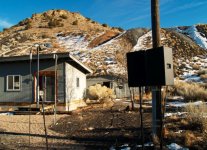Hi Bob,
Your post would imply that placing the two speakers next to each other will result in a 3dB increase in sound level, as they are now acoustically coupled.
People are in bed here, so I'll leave this quick test in your capable hands.
Alternatively, with an SPL meter running, disconnect a speaker and see what the level drop is.
I'd be interested to hear of your results: I'll be trying the above experiments tomorrow.
For now, goodnight
Chris
There will be a 3 dB increase of SPL in the room. You will just have twice the power transmited to the air. There is no real increase in efficency as you will now use twice the power also.
Wrong. Doubling power and cone area results in a 6 dB increase when the cones are within 1/4 wavelength.There will be a 3 dB increase of SPL in the room. You will just have twice the power transmited to the air. There is no real increase in efficency as you will now use twice the power also.
See post 220 for proof.
I ran 2 'tests' in my listening room. The RS SPL meter was at the listening position, approximately 10 feet from the speakers. In each test I applied a test signal, took a meter reading, then disconnected one channel and took a second meter reading. For both tests the drop in spl was very obvious to the ear. Test #1 used white noise (fm interstation noise). Test #2 used music (meter set to 'slow' to average out the beat). Both tests showed a 3db drop going from 2 to 1 speaker. There was really no ambiguity or difficulty reading the meter. With music you do need to use something that has a consistent beat during the test. An fm rock station provided a good signal due to the substantial compression used. Anyway, its 20 minutes to midnight and tomorrow is a work day.
Signing off,
Bob
Signing off,
Bob
Interesting.
Has anyone tried moving the speakers together with music playing?
Recent posts would imply you could gain another 3dB. 😕
Edit - just seen this linked in another thread. http://www.linkwitzlab.com/faq.htm#Q21
Has anyone tried moving the speakers together with music playing?
Recent posts would imply you could gain another 3dB. 😕
Edit - just seen this linked in another thread. http://www.linkwitzlab.com/faq.htm#Q21
Last edited:
I've tried to measure the voltage to my Dali ASX 8000 with specsheet sensitivity 92 dB, but I couldn't get a readout on the DMM, since the lowest setting for V AC is 200 V.
I will have to buy a new DMM
I will have to buy a new DMM
Wrong. Doubling power and cone area results in a 6 dB increase when the cones are within 1/4 wavelength.
See post 220 for proof.
True. But only if the drivers are in parallel 🙂. You can't really state that a stereo system has the speakers in parallel, and also that the speakers are 1/4 close to each other.
They are effectively in parallel, and I can say it if I want to.
Assuming a mono signal (I know it isn't, but music is so variable that we won't go there), adding a second channel and speaker doubles the current output of the amplifier. Its output voltage does not change.
Therefore, for all intents and purposes, the drivers are in parallel.
Chris
Assuming a mono signal (I know it isn't, but music is so variable that we won't go there), adding a second channel and speaker doubles the current output of the amplifier. Its output voltage does not change.
Therefore, for all intents and purposes, the drivers are in parallel.
Chris
A recent thread among many about the subject:
http://www.diyaudio.com/forums/multi-way/138121-woofers-working-together-3db-6db.html
http://www.diyaudio.com/forums/multi-way/138121-woofers-working-together-3db-6db.html
There is an additional 3db gain "only if the drivers are in parallel "
Works for ss amps that are capable of doubling current into halved loads (for example 20w @ 8 ohms and 40w @4 ohms). Very few are built with power supplies that allow this.
Also, transformer coupled tube amplifiers (like the one I used in my tests) do not allow this gain. With these amplifiers, when the load impedance is changed from say 8 ohms to 4 ohms, one must connect the load to the 4 ohm secondary (avoids an impedance mismatch - speaker to output tube plates and resulting power delivery and distortion deterioration).
"adding a second channel and speaker doubles the current output of the amplifier. Its output voltage does not change."
I think this is double counting. The spl added by the second channel has already been counted as +3db. It effectively doubles the amount of power and sound being delivered to the room, hence +3db.
This does get confusing.
Regards,
Bob
Works for ss amps that are capable of doubling current into halved loads (for example 20w @ 8 ohms and 40w @4 ohms). Very few are built with power supplies that allow this.
Also, transformer coupled tube amplifiers (like the one I used in my tests) do not allow this gain. With these amplifiers, when the load impedance is changed from say 8 ohms to 4 ohms, one must connect the load to the 4 ohm secondary (avoids an impedance mismatch - speaker to output tube plates and resulting power delivery and distortion deterioration).
"adding a second channel and speaker doubles the current output of the amplifier. Its output voltage does not change."
I think this is double counting. The spl added by the second channel has already been counted as +3db. It effectively doubles the amount of power and sound being delivered to the room, hence +3db.
This does get confusing.
Regards,
Bob
FWIW, I measure +3dB with two channels vs one channel on my system.
That's with pink noise, C weighting, slow response. Ditto on warble tones.
That's with pink noise, C weighting, slow response. Ditto on warble tones.
Pano,FWIW, I measure +3dB with two channels vs one channel on my system.
That's with pink noise, C weighting, slow response. Ditto on warble tones.
Did you disconnect one speaker or use the pan pot for that test?
Rooms don't fit theory too well.Disconnected one RCA input cable.
I expected 6dB, but didn't see it.
David McBean said this morning Hornresp goes on the assumption of a 6dB increase at LF and a 3 dB increase at HF.
My testing has primarily been at LF, never noticed that to be true.
The snow and mud have cleared enough, I'm going to do an outdoor full range test and see what happens, will post the results later.
As promised, test results with graphs are below.Disconnected one RCA input cable.
I expected 6dB, but didn't see it.
Weather outside was decent, about 45 F, but my A/D test interface crapped out, spent an inordinate amount of time checking out the five mic cords in series before finding the problem was in a bad mic preamp.
Then spent more time figuring out how to get Smaart working with the Macbook audio in/ out.
12:30 to 4:30 from set up to tear down, probably only 20 minutes of which was actual test time..
The tests were done with the mic on axis 2 meters from the speakers, which were on stands elevating the acoustical center to 2 meters.
Tests were done with the speakers together, and 2 meters on center spread between them.
In both cases, the average level difference between one and two was uniformly about 6 dB throughout the range of the speakers.
Above 5000 Hz, the gain (or loss) is erratic due to the wavelengths being so small and the speakers , being on unlevel ground were not exactly equidistant to the microphone, causing dips in response (AKA “comb filtering”, or cancellation).
Also of note, because the speakers used are not perfectly matched (as can be seen in the lower two “2x6spread” screen shot) summation is not exactly 6 dB, though quite close.
In room results will of course vary, but in a “perfect” room, with “perfect” speakers, the test verifies that a 6 dB increase from one to two equally powered speakers should be seen across the entire audio range.
That said, perfect rooms and perfect speakers only exist in a perfect fantasy.
Art
Attachments
Thanks Art. Very good test, thanks for posting.  And I see you live in the middle of nowhere.
And I see you live in the middle of nowhere.
I'll try again when I get a chance. I really expected more than 3dB from my system.
 And I see you live in the middle of nowhere.
And I see you live in the middle of nowhere.I'll try again when I get a chance. I really expected more than 3dB from my system.
Perhaps the added room reflections mean output, masking about 3dB of loss?
That's the only explanation I have.
As a thought, I can try connecting my subwoofers and Fostexes independently. I only have an SPL meter on my iPod, but it ought to be okay for relative levels, I'll try overall difference (ie, unplug an input lead), and difference only running Fostexes (>80Hz), and only running subs (<80Hz)
Chris
That's the only explanation I have.
As a thought, I can try connecting my subwoofers and Fostexes independently. I only have an SPL meter on my iPod, but it ought to be okay for relative levels, I'll try overall difference (ie, unplug an input lead), and difference only running Fostexes (>80Hz), and only running subs (<80Hz)
Chris
Thanks Art. Very good test, thanks for posting.And I see you live in the middle of nowhere.
I'll try again when I get a chance. I really expected more than 3dB from my system.
I tried last night with a pr of 1.6 maggies and got 5 db @ 3M .....
Art, thank you very much for doing this test, which confirms theory for coincident sound sources in a practical way.
I guess Hornresp (never worked with it myself) is correct for music signals, where LF is normally coincident, and HF incoincident.
This, in addition to the fact that room gain is most pronounced for LF, is good caution against applying too much baffle step compensation while designing speakers.
vac
I guess Hornresp (never worked with it myself) is correct for music signals, where LF is normally coincident, and HF incoincident.
This, in addition to the fact that room gain is most pronounced for LF, is good caution against applying too much baffle step compensation while designing speakers.
vac
I performed another test last night, in a smaller room (10x13 ft) using BR enclosed Fe-103's. There was just under 3 db increase going from 1 - 2 speakers, and an additional 2 db from moving them together.
There appears to be a pattern of test results, with open air tests (4 pi space) yielding a 6 db increase, while tests performed in listening rooms (folded 2 pi space?) only yield a 3 db increase. These results may indicate that the testing (acoustical) environment is itself an important (perhaps critical) factor.
"In room results will of course vary, but in a “perfect” room, with “perfect” speakers, the test verifies that a 6 dB increase from one to two equally powered speakers should be seen across the entire audio range."
Perhaps the only perfect room is no room (i.e., 4 pi space), and perfect measurements, in a perfect room with perfect speakers will not change 2 pi space into 4 pi space. The measurements reflect natural laws in both cases. It would be most interesting if Art (or someone else) would repeat his outdoor tests in-room. It's getting dark here by the time I get home from work, so that will have to wait until the weekend for me.
There is some interesting and related discussion in this thread on the cause of the baffle step 6 db loss: http://www.diyaudio.com/forums/multi-way/200566-baffle-step-loss-why-6db-3.html
Regards,
Bob
There appears to be a pattern of test results, with open air tests (4 pi space) yielding a 6 db increase, while tests performed in listening rooms (folded 2 pi space?) only yield a 3 db increase. These results may indicate that the testing (acoustical) environment is itself an important (perhaps critical) factor.
"In room results will of course vary, but in a “perfect” room, with “perfect” speakers, the test verifies that a 6 dB increase from one to two equally powered speakers should be seen across the entire audio range."
Perhaps the only perfect room is no room (i.e., 4 pi space), and perfect measurements, in a perfect room with perfect speakers will not change 2 pi space into 4 pi space. The measurements reflect natural laws in both cases. It would be most interesting if Art (or someone else) would repeat his outdoor tests in-room. It's getting dark here by the time I get home from work, so that will have to wait until the weekend for me.
There is some interesting and related discussion in this thread on the cause of the baffle step 6 db loss: http://www.diyaudio.com/forums/multi-way/200566-baffle-step-loss-why-6db-3.html
Regards,
Bob
It won't be me doing the inside vs outside. My speakers weigh more than I do (and that's saying something) so I won't be dragging them outside. 🙁
I may get a chance with a pair of powered speakers at the shop, similar to what Art did. But it would be next week at the earliest.
I may get a chance with a pair of powered speakers at the shop, similar to what Art did. But it would be next week at the earliest.
- Status
- Not open for further replies.
- Home
- Loudspeakers
- Full Range
- High efficiency speakers - how much power do they really need?



